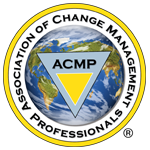Organizations are experiencing an astounding rate of business change. Changes designed to improve market share, competitive advantage, operational efficiency and shareholder return have multiplied at an alarming rate—so many projects chasing too few resources. In short, everyone wants to get better, faster.
However, while many organizations are quite competent at getting these business changes installed—meaning they are up and running, more often than not, they fail to get the changes fully implemented. There is no behavior change, or the behavior is adopted for only a short time.
70% or more of all major changes initiatives fail to deliver on time, on budget, to spec. The question is, why?
Barriers to Implementation
While most organizations spend the bulk of their resources and energy on the technical and business process components during a change, the greatest risk for failure or sub-optimization is actually on the human side of the equation.
In our 30+ years of Change Management Consulting we’ve seen plenty of failed attempts at change. Here are a few of the common causes for sub-optimal performance we’ve experienced:
- Projects are poorly defined and metrics for success are not commonly understood
- Users don’t adopt new processes; use work-arounds rather than accept new tools/methods so operational efficiencies aren’t realized
- There is weak accountability in the middle layers of the organization for implementation success
- Resistance generated from the degree of work disruption is covert, unmanaged and slows down change
- Old reinforcements are applied and don’t match new expectations
- Leaders at all levels don’t take an active role in change implementation
- Use of multiple approaches for enterprise-wide change reinforce “silo” mentality
- Organizations are seduced by the frenetic activity of project teams
- Organizations confuse installation with implementation and therefore declare success too early
Simply put, to a large extent organizations just don’t apply business-discipline and rigor for managing the human elements of complex, large-scale change.
To fight back against the plague of sub-optimized projects, organizations need to employ a structured approach to implementation, with skilled leaders and Change Agents who have explicit accountabilities, rewards, and consequences for the implementation of change projects. Organizations need implementation capability, not just installation capability, if the organization is going to achieve full Return on Investment.
Accredited Practitioners are the First Line of Defense
Organizations can fight back by employing a repeatable process for implementing changes. The Accelerating Implementation Methodology (AIM) change management methodology brings the same kind of discipline typically reserved for technical and business objectives to the human and cultural elements. It’s a flexible, but business-disciplined change management methodology that is scalable for projects of any size or complexity, from every day changes to transformational change.
AIM can be applied to any kind of initiative or project. It’s project management for the people-side of implementation, with deliverables, tools, and measurement assessments that enable the organization to apply process where there has been none. And like any well thought-out process, AIM deliverables are planned, managed, and measured, just as the organization manages the financial and operational components of its business.
Building AIM capability starts with a critical mass of individuals with awareness of the methodology principles, vocabulary, tactics and strategies that is then supported by a core group of Accredited Practitioners who serve as AIM super-users. These Accredited Practitioners become the first line of defense, mentoring and coaching other Change Agents. Project by project, your Accredited Practitioners and Change Agents work hand in hand with your Sponsors to help ensure the leaders are actively cascading commitment to the changes.
AIM is well-tested, with proven results. In fact, we’ve certified close to 3,000 people globally in this powerful change management methodology. And now IMA is proud to announce the AIM Accreditation program has been approved for 30 credit hours as a Qualified Education Provider by the Association of Change Management Professionals (ACMP).
If you are implementing your current changes in the same way you have implemented projects in the past, but expecting different results, you will likely be disappointed--and become another statistic. What are you doing to change the implementation process so you drive to full value realization on your project?



